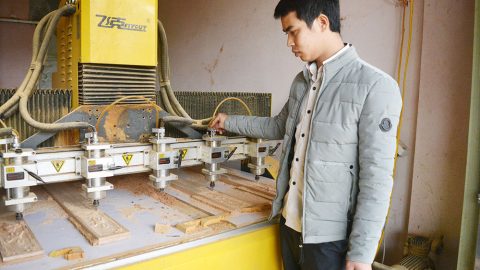
Mr. Doan Tuan Anh's wood manufacturing and processing facility in Du Ba carpentry village, Tuy Loc commune
In the context of increasing international economic integration, technological innovation, application of scientific and technical advances into production are considered as one of the key solutions, becoming Survival factors for handicraft villages. However, in fact, technological innovation in handicraft villages is not easy, especially for traditional villages…
Thanks to the effective implementation of many mechanisms to encourage and support handicraft village households to innovate technology and apply science and technology through industrial promotion policies, small industry and handicraft industry development programs and projects. In order to support of agricultural and rural production, many handicap village households have gradually changed their production and investment thinking and equipped with modern machines, using automatic technology applied to some stages or the whole manufacturing process. Thereby, not only shortening the manual stages, improving productivity, reducing production costs, increasing competitiveness for products, but also contributing to freeing the labor force and improving the handicraft village environment.
Du Ba carpentry village, Tuy Loc commune, Cam Khe district has been recognized as a traditional village since 2005, currently has more than 100 households engaged in production, producing an average of hundreds of thousands of products and consumption in the town every year. In and outside the province, the average turnover of handicraft villages is estimated at over VND 30 billion/year, contributing to creating jobs for over 600 laborers. In the past, most of the households used old and semi-automatic machines, which made labor productivity low and labor intensive. Until now, the carpentry village of Du Ba is gradually changing thanks to applied modern science and technology in production.
Like many households working in the commune, previously, Doan Tuan Anh’s workshop mainly produced manually, to ensure the volume of goods, at one point the family had to hire nearly 20 employees. In order to innovate technology, apply scientific and technological advances to production, he invested over VND 700 million to buy modern machines such as cutting machines, chisels… with automatic computer programming. Thereby helping to reduce the number of regular workers to 6-8 employees. He said: Currently most of the production and processing stages of the family have the participation of machines. If before, to make a product, a skilled carpenter would take a whole month to complete, now with automatic chisel, the time to complete the product was shortened to several hours. The use of machines instead of manual labor has increased productivity, increased uniformity, quality assurance for products as well as saving time, reduce production costs and make profitability of goods go higher.
Not only Du Ba carpentry village, technological innovation is also gradually being focused on the handicraft villages. The effectiveness from technological innovation in production in handicraft villages is quite clear, however, in fact, technological innovation and application of scientific and technological advances to production in handicraft villages are still limited, causing many difficulties in developing handicraft villages, in which the biggest obstacle is investment. To convert stages from manual to modern, semi-automatic or semi-automatic machines, a large amount of investment capital is required from a few tens of millions to hundreds of million VND per machine.
According to the representative of the Rural Development Department, for handicraft villages to overcome technological barriers, first of all, it is necessary to solve the problem of investment capital. In addition to promoting the implementation of industrial promotion policies, local authorities should strengthen coordination with functional sectors to continue to support technology transfer and application of advanced machines to production, encouraging handicraft households invest in equipment, apply advanced science and technology into production, gradually replace manual stages, towards automatic production. Implementing the plan of developing trade villages in association with the development of agricultural, industrial and small-scale handicraft industrial development plans towards the production of goods and creating favorable conditions for mechanized production.